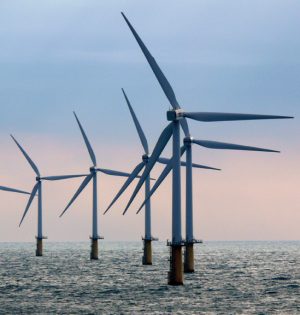Offshore wind power has been receiving a great deal of attention as a possible large source of future electric power. While Europe has been making major investments in this power source for years, the U.S. and New York are just now starting to focus on its potential. Later this year, America”™s first offshore wind farm near Block Island, R.I. is expected to be operational, generating 30 megawatts of power.
On Sept. 15, the New York State Energy Research and Development Authority (NYSERDA) released a blueprint discussing New York”™s available offshore wind energy. The blueprint is part of Gov. Cuomo”™s commitment to reduce carbon emissions by 40 percent and generate 50 percent of the electricity consumed in New York from renewable sources by 2030. A final plan for achieving this is expected by the end of 2017.

Harnessing offshore wind
On March 16, the U.S. Bureau of Ocean Energy Management identified a Wind Energy Area 11 miles off the coast of Long Beach. On June 2, the Dept. of the Interior announced the proposed sale of this same WEA for a commercial wind farm. This federal policy established the foundation for New York to identify and promote offshore wind power.
NYSERDA has announced its participation in the lease auction. In an April cost analysis, NYSERDA identified 12 offshore New York locations, which could generate up to 11,440 megawatts, enough power to generate over 3.6 million homes, with an estimated cost of $5.2 million per megawatt.
The NYSERDA blueprint found enormous potential for offshore wind power ”” 39 gigawatts of offshore wind energy, enough to power approximately 15 million homes.
Challenges and opposition
Like conventional on-land sources of electricity, offshore wind energy faces challenges.
Offshore wind installation costs approximately twice as much as onshore wind farms. It also has additional costs, such as the need to update transmission infrastructure. With much of New York”™s transmission infrastructure more than 30 years old, significant improvements are needed before introducing new power sources to the grid.
As an intermittent power source, wind on average only produces 30 percent to 35 percent of capacity. While NYSERDA”™s maximum projection of 11,440 megawatts in energy generated from offshore wind is large, New York would receive less than 4,000 megawatts of offshore wind generation day to day. For perspective, New York has 39,039 megawatts of electricity generating capacity.
In addition to costs and transmission challenges, there are other large hurdles, including the following.
Not-in-my-backyard (NIMBY) opposition almost always occurs when large energy projects are proposed in New York. In fact, the strong local opposition in Massachusetts to the Cape Wind project may be indicative of the opposition that New York”™s offshore wind projects could face.
Bird migratory and marine life issues will also be a concern, especially given the vast size of many offshore wind facilities.
Preserving sea lanes will be an important consideration, especially as New York”™s economy thrives on trade, particularly from ocean transport.
Financing challenges are also an issue with many large proposed energy infrastructure projects. Simply put, many are proposed and then withdrawn. Because of changing economics and the delays and uncertainties in getting new projects built, many companies and investors withdraw these high-priced proposals.
While wind power can help in achieving clean energy goals, it is critical that we keep clean, baseload power on the grid to meet energy demands. With electricity demands, especially peak demands rising, New York will need to have many clean, non-carbon emitting sources to achieve the state”™s environmental goals.
Matthew C. Cordaro is a trustee of the Long island Power Authority and serves on the advisory board of the New York Affordable Reliable Electricity Alliance (New York AREA). He is a former president and CEO of the Midwest Independent Transmission System Operator Inc. and of Nashville Electric Service, a public utility.Â























Offshore and onshore wind need to compete in the US energy markets without subsidies or government supports. We should stop doing the stupid things Europe and California do. There is no “infant industry” reason for support programs for wind (or Solar PV) energy today.